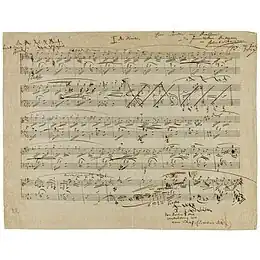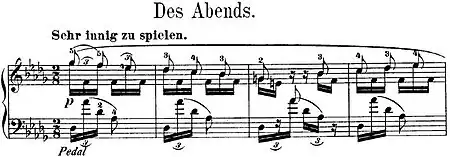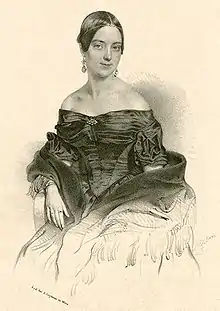Robert Schumann's Fantasiestücke, Op. 12, is a set of eight pieces for piano, written in 1837. The title was inspired by the 1814–15 collection of novellas, essays, treatises, letters, and writings about music, Fantasiestücke in Callots Manier (which also included the complete Kreisleriana, another source of inspiration for Schumann) by one of his favourite authors, E. T. A. Hoffmann. Schumann dedicated the pieces to Fräulein Anna Robena Laidlaw, an accomplished 18-year-old Scottish pianist with whom Schumann had become good friends.[1]
Schumann composed the pieces with the characters Florestan and Eusebius in mind, representing the duality of his personality. Eusebius depicts the dreamer in Schumann while Florestan represents his passionate side. These two characters parlay with one another throughout the collection, ending self-reflectively with Eusebius in "Ende vom Lied".
Details

1. "Des Abends" ("In the Evening") in D♭ major / Sehr innig zu spielen (Play very intimately) Con molto affetto

Schumann, after completing the work, then gave the piece its title, which introduces the character of Eusebius, who serves as a symbolic representation of Schumann's dreamy self. He intended the imagery to be a "gentle picture of dusk."[2]
2. "Aufschwung" ("Soaring", literally "Upswing") in F minor / Sehr rasch (Very rapidly) Molto allegro

Schumann conceived of "Aufschwung" as a depiction of the character Florestan indulging in his desires, and as the Norton Anthology of Western Music describes "at the height of his passions."[3]
3. "Warum?" ("Why?") in D♭ major / Langsam und zart (Slowly and tenderly) Lento e con soavita

The title "Why?" was intended by Schumann to signify Eusebius's reflection on the excesses of Florestan in "Aufschwung".[3] The piece proceeds with "gentle questioning" and ends with an "inconclusive answer."[2]
4. "Grillen" ("Whims") in D♭ major / Mit Humor (With humor) Con spirito

With its whimsical, quirky nature, this piece solely represents Florestan and his eccentricities.[2]
5. "In der Nacht" ("In the Night") in F minor / Mit Leidenschaft (With passion) Con passione

The two characters of Florestan and Eusebius (the interaction of which Schumann was attempting to represent within the Fantasiestücke) unite for the first time in this piece, which has both "passion together with nocturnal calm."[2] Schumann said to Clara to have perceived in "In der Nacht" the story of Grillparzer's Hero and Leander, albeit not until after writing it: "It is an old and beautiful romantic legend. When I play ′Die Nacht′ [sic] I can never forget this image: first he plunges into the sea – she cries out – he answers – he swims safely to shore through the waves – now the cantilenas as they embrace – then he must leave but cannot bear to part – until night again enshrouds everything in darkness. – To be sure, I imagine Hero to be exactly like you; and if you were sitting atop a lighthouse I, too, would probably learn how to swim. But tell me whether you too think this image fits the music."[4]
6. "Fabel" ("Fable") in C major / Langsam (Slowly) Lento

Like the previous piece, this also juxtaposes both the passionate and dreamy side of Schumann within the same work (as opposed to representing each separately, as in the first subset). The key of C major breaks from the pattern of D♭ major/F minor established by the previous pieces. In this piece, the whimsical nature of Florestan is set against the ethereal tranquility of Eusebius, resulting in a "placid narrative together with rich veins of humor."[2]
7. "Traumes Wirren" ("Dream's Confusions") in F major / Äußerst lebhaft (Extremely lively) Vivacissimo

The title is implicative of the struggle between the dreams and the passions within Schumann. In this piece the dreamy quality of Schumann, represented by the character of Eusebius, becomes entangled by the passions of Florestan, who symbolizes Schumann's more emotional side. Like the previous piece, this piece also departs from the established D♭ major/F minor key signature scheme, as it is written in the key of F major which is also the key of "Ende vom Lied", the next piece. The piece is rhythmically intense and a rapid pulse permeates it.[2]
8. "Ende vom Lied" ("End of the Song") in F major / Mit gutem Humor (With good humor) Con spirito

Schumann described this piece as a combination of wedding bells and funeral bells. In a letter to his fiancée Clara Wieck, who would become his wife, Clara Schumann, three years later, he wrote about this last piece: "everything ultimately dissolves into a merry wedding – but my distress for you came back at the end, and the wedding bells sound as if commingled with a death knell."[2][4]
See also
References
- ↑ J. C. Hadden; rev. Anne Pimlott Baker. "Laidlaw , Anna Robena Keddy (1819–1901)", Oxford Dictionary of National Biography, Oxford University Press, 2004; online ed., May 2008, accessed 28 January 2015 (subscription required)
- 1 2 3 4 5 6 7 Ewen, David, The Complete Book of Classical Music, p. 474, Prentice Hall, 1965
- 1 2 J. Peter Burkholder, Claude V. Palisca, Norton Anthology of Western Music, Vol. 2: Classic to Twentieth Century, fifth edition, Norton, New York London, 2006
- 1 2 Schumann, Robert (2004). Herttrich, Ernst (ed.). Fantasiestücke op. 12 (PDF) (in German and English). München: G. Henle Verlag. pp. IV–V.
External links
- Fantasiestücke, Op. 12: Scores at the International Music Score Library Project
- Free score at kostenlose-klaviernoten.de
- Notes at Naxos Records
- "Fabel" and "Traumeswirren" from Fantasiestücke played by Arthur Rubinstein at Internet Archive (Open Source Movies)
- Animated score on YouTube, Martha Argerich
- Live Performance on YouTube, Seong-Jin Cho
